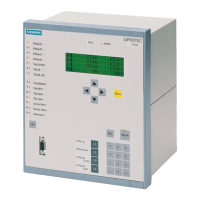'(& )( )'& &) ( &!& ")& &$(( $# Ć %&( $# #)" &&#$
Technical data
3
3 - 5
Siemens AG ⋅ May 1998
3.2 Service conditions
Static protective devices are designed for use in stanĆ
dard relay rooms and compartments so that with proĆ
per installation electro-magnetic compatibility (EMC)
is ensured. The following should also be heeded (if
applicable):
D All contactors and relays which operate in the
same cubicle or on the same relay panel as the
digital protection equipment should, as a rule, be
fitted with suitable spike quenching elements.
D All external measuring leads in substations from
100 kV upwards should be screened with a screen
capable of carrying power currents. No special
measures are normally necessary for medium-volĆ
tage substations.
D It is not permissible to withdraw or insert indivi-
dual modules under voltage. In the withdrawn conĆ
dition, some components are electrostatically enĆ
dangered; during handling, the standards for
electrostatically endangered components must be
observed. The modules are not endangered when
plugged in.
3.3 Inter-changeability
D Devices
Protective devices in housings or racks fitted at
the factory are delivered complete and can be inĆ
terchanged as a unit with identical ordering codes.
The threshold of binary inputs has to be matched
with the station data.
D Modules
Plug-in modules are, in general, interchangeable if
the type designations up to the oblique stroke are
identical (the characters behind the oblique stroke
contain internal factory data which do not normally
affect the inter-changeability). With modules ZPS,
however, the address settings must be checked
and with modules EAZ the address setting and
threshold setting must be checked and adapted by
jumpers.
Should it become necessary to exchange any digital
device or module, the complete relay settings should
be checked. Respective notes are contained in chapĆ
ter 6.
3.4 Busbar protection
Table 3.5 Busbar protection
Characteristic Stabilized differential current measurement
Setting ranges Overcurrent /
norm
1)
Stabilizing factor K for bus-section specific proĆ
tection
Stabilizing factor K for the check zone
0,2 to 4,00 (in steps of 0,01)
0,5 to 0,8 (in steps of 0,01)
0 to 0,8 ((in steps of 0,01)
Diff-current supervision
Setting ranges Current limit value /
norm
1)
Time delay
0,05 to 0,8 ( in steps of 0,01)
2)
1,0 to 10 s (in steps of 1)
2)
Tripping time typical trip time 15 ms
1)
Norm
= normalized nominal current referred to the current transformer with the highest ratio (base CT)
2) Identical setting ranges for the zone-selective protection and the check zone

